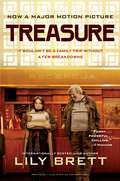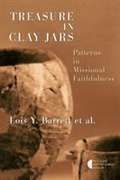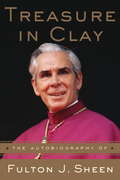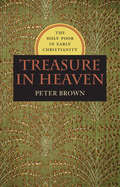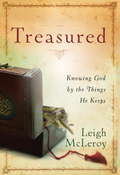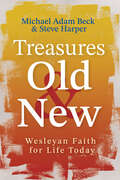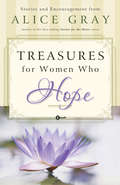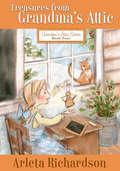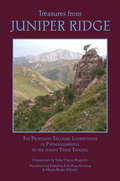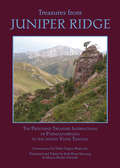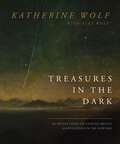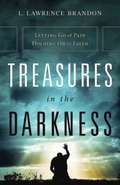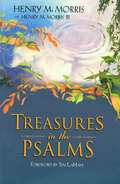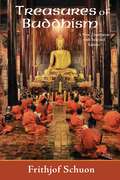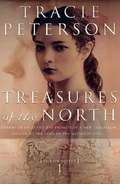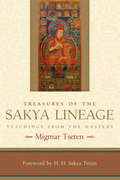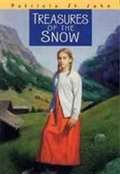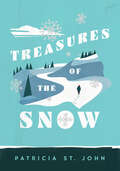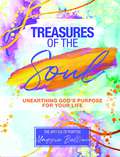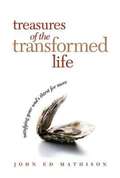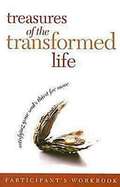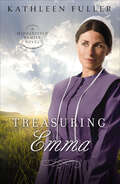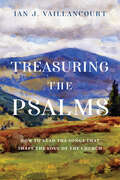- Table View
- List View
Treasure [Movie Tie-in]: A Novel
by Lily BrettSOON TO BE A MAJOR MOTION PICTURE STARRING LENA DUNHAM AND STEPHEN FRY.A "haunting, riotously funny, and deeply touching" (Publishers Weekly) novel about a woman and her father's journey to Poland to revisit her family historyRuth Rothwax finds order and meaning in the words she writes for other people, but she can’t find words to understand the loss her family experienced during World War II. She becomes obsessed with the idea of returning to Poland with her father, Edek, making sense of her family’s past, and visiting the places where her beloved parents lived and almost died. But there’s more to this trip than Ruth can plan for. By facing Poland and the past, she might be able to confront her own future.Treasure is the gripping story of a woman’s search for memory and meaning, and the reconciliation of present and past within the complicated fabric of family. Acclaimed bestselling author Lily Brett explores the reverberations of loss through this remarkable and unforgettable journey of the heart."[Brett] has an incredibly ability to explain the Jewish experience, and the human experience." — LENA DUNHAM"[Brett's] such an easy writer to read... beautifully funny, complex, and delightful as well." — STEPHEN FRY
Treasure in Clay Jars: Patterns in Missional Faithfulness
by Lois BarrettIf you saw a missional church, what would it look like? What patterns of behavior and practice would you find there? <p><p> Building on the ground laid by the book Missional Church: A Vision for the Sending of the Church in North America (Darrell Guder et al. 1998), Treasure in Clay Jars centers on case studies of nine missional congregations from across North America that are diverse in their denominational affiliations, worship styles, political stances, and socioeconomic backgrounds. The book explores eight concrete “patterns” common to these churches. Although the patterns may be different in each setting, they can be recognized in any congregation seeking to participate in God’s mission in the world. <p> The team that authored this book believes that “missional” says something not so much about the activities of the church as its character: “The church does not exist for itself, but for participation in God’s mission of reconciliation. . . . Mission is the character of the church in whatever context it exists.” The congregations studied here are “clay jars,” but each carries in its witness a remarkable treasure that points to God’s power and purposes.
Treasure in Clay: The Autobiography of Fulton J. Sheen
by Fulton J. SheenThis autobiography includes childhood and seminary reflections, his view of media stardom, pastoral work, international travels, conversions, Vatican II, Mary and more. Listeners can expect to hear many of this saintly and sage communicators famous phrases and inspiring stories. Here in Sheen's own words are reflections from his childhood, his years in seminary, his academic career, his media stardom, his pastoral work, his extensive travels, and much more.
Treasure in Heaven: The Holy Poor in Early Christianity (Richard Lectures)
by Peter BrownThe "holy poor" have long maintained an elite status within Christianity. Differing from the "real" poor, these clergymen, teachers, and ascetics have historically been viewed by their fellow Christians as persons who should receive material support in exchange for offering immeasurable immaterial benefits--teaching, preaching, and prayer. Supporting them--quite as much as supporting the real poor--has been a way to accumulate eventual treasure in heaven. Yet from the rise of Christian monasticism in Egypt and Syria to present day, Christians have argued fiercely about whether monks should work to support themselves. In Treasure in Heaven, renowned historian Peter Brown shifts attention from Western to Eastern Christianity, introducing us to this smoldering debate that took place across the entire Middle East from the Euphrates to the Nile. Seen against the backdrop of Asia, Christianity might have opted for a Buddhist model by which holy monks lived by begging alone. Instead, the monks of Egypt upheld an alternative model that linked the monk to humanity and the monastery to society through acceptance of the common, human bond of work. This model of Third World Christianity--a Christianity that we all too easily associate with the West--eventually became the basis for the monasticism of western Europe, as well as for modern Western attitudes to charity and labor. In Treasure in Heaven, Brown shows how and why we are still living--at times uncomfortably--with that choice.
Treasured: Knowing God by the Things He Keeps
by Leigh McleroyCigar boxes. Refrigerator doors. Scrapbooks and sock drawers and top shelves. These are the places we store our treasures–the keepsakes that tell the story of whom and what we’ve loved, how we’ve lived, and what matters most to us. God is a collector, too, whose treasures are tucked securely into the pages of his book: a golden bell here, an olive leaf there, a scarlet thread, a blood-stained cloth, a few grains of barley. Each of these saved artifacts reveals a facet of his heart and tells the story of a Father whose most precious possession is…us. InTreasured,Leigh McLeroy considers tangible reminders of God’s active presence and guides us in discovering evidence in our own lives of his attentive love.
Treasures Old and New: Wesleyan Faith for Life Today
by Steve Harper Michael Adam BeckThe way forward requires both old ways and new ways!Step into the world of Wesleyan beliefs and practices with this small, insightful, and impactful book! Join the Wesleys on their journey through early Methodism, and unlock hidden treasures that are still relevant today. Harper and Beck expertly guide readers towards a new era of Christian experience, combining old traditions with modern approaches for a revitalized church community. With its compact size, this book is perfect for leaders looking to unite their congregations around Methodist identity and future direction. Don’t miss out on this essential resource for shaping the next chapter in your faith journey!This book is a must-read for anyone in the Wesleyan faith stream, those involved in fresh expressions and other unconventional faith communities, and leaders within Wesleyan communities. Discover the heart of Methodist tradition, envision its relevance today, and boldly share these timeless treasures and new visions with others.
Treasures for Women Who Hope
by Alice GrayAs much as we long for blue skies and smooth sailing, storms and rocky times are inevitably a part of our lives. Sometimes the storms hit suddenly and fiercely, leaving behind terrible devastation. Other times the storms are silent clouds of desperation lingering on the horizon, threatening to rock everything we hold dear. Often, hope is the only comfort and joy we can know in the midst of these hard times. In Treasures for Women Who Hope, best-selling author Alice Gray offers comfort and encouragement to women through an insightful look at God's Word and through the lives of others. Filled with touching stories of those who have faced insurmountable odds and yet still found hope, Alice shares principles and practices from Scripture that remind us that our sometimes-darkened path is never without hope. Other titles in the series will include: Treasures for Women Who Make a Difference Treasures for Women Who Love God Treasures for Women Who Pray Treasures for Women Who Forgive Treasures for Women Who Become Beautiful
Treasures from Grandma's Attic
by Arleta Richardson Patrice BartonJourney back to Grandma's childhood on a Michigan farm in the 1800s for heartwarming stories that inspire faith and godly character. Arleta Richardson's beloved series, Grandma's Attic, returns with Treasures from Grandma's Attic, the fourth in the refreshed classic collection for girls 8 to 12. This compilation of tales recounts humorous and poignant memories from Grandma Mabel's childhood on a Michigan farm in the late 1800s. Combining the warmth and spirit of Little House on the Prairie with a Christian focus, this book transports readers back to a simpler time to learn lessons surprisingly relevant in today's world. Richardson's wholesome stories have reached more than two million readers worldwide. Parents appreciate the godly values and character they promote. Children love the captivating storytelling that recounts childhood memories of mischief and joy. Ideal for home, school, or church libraries, or to give as a gift certain to be treasured.
Treasures from Juniper Ridge
by Erik Pema Kunsang Marcia Binder Schmidt Tulku Urgyen PadmasambhavaTreasures from Juniper Ridge is a collection of "hidden" or terma teachings given by Padmasambhava, the Tantric master who brought Vajrayana Buddhism to Tibet. According to Tulku Urgyen Rinpoche, Padmasambhava hid many teachings to be uncovered later by "revealers of hidden treasures." The special quality of the terma teachings is that they provide guidance appropriate for each period of time and individual person. By working with Padmasambhava, Yeshe Tsogyal, his mystic spiritual consort, was able to compile and codify these precious insights and hide them for use by future generations. Treasures from Juniper Ridge presents a variety of significant revelations for seekers on the advanced path of the Tibetan Vajrayana tradition, as well as in-depth explanations of assorted aspects of practice: deity-focused meditation, nonconceptual meditation, death and dying, and recognizing the nature of mind. The book outlines ways for the modern student to apply these teachings while remaining true to Vajrayana Buddhism's traditional principlesFrom the Trade Paperback edition.
Treasures from Juniper Ridge
by Erik Pema Kunsang Tulku Urgyen Rinpoche Padmasambhava Guru Rinpoche Yeshe TsogyalTreasures from Juniper Ridge combines meditation and pith practiceinstructions in a way that is easy to apply and comprehend. It is a compilationof discovered teachings, termas, by the greatest master of VajrayanaBuddhism, Padmasambhava, hidden by his female disciple, Yeshe Tsogyal.Treasures is replete with pieces that are direct, profound, fresh, and pertinentto our times.These various revelations are for all levels of practitioners. They provide indepth explanations of assorted aspects of practice, including: deity, deathand dying, non-conceptual meditation and recognizing mind nature. Thebook outlines ways to apply these teachings for the modern student, whileremaining true to traditional principles."Padmasambhava's pith instructions are extremely important because heis not just a legendary figure or an ancient myth. He is an actual personwho continuously carries out spontaneous activities, including manifestingas treasure revealers, so that there is always a fresh, unimpaired teachingthat people can practice. This also ensures that Padmasambhava's spiritualinfluence and blessings are unceasing.The special quality of these terma teachings is that they provide a methodfor accomplishment that is appropriate for each specific generation, periodof time, and individual person who meets them. The treasure teachingshe gave on the Juniper Ridge of Crystal Pearls contain the essential meaningof hundreds of such instructions."-Tulku Urgyen Rinpoche
Treasures in the Dark: 90 Reflections on Finding Bright Hope Hidden in the Hurting
by Katherine WolfSometimes the most valuable treasures are found in the darkest of times. In fact, it's often in the very heart of our deepest pain and struggle that God chooses to reveal his most precious gifts. Let Katherine Wolf lead you in finding the hope God has for you in your most painful places.In our lowest, most difficult moments, it's often impossible to see any good thing around us. We suffer, we struggle, we grow weary. We wonder, Is God at work in my life? Is he near me? Is there any point to my suffering and any hope for change?Though it's easy for our overwhelming pain to cloud our view of reality, the truth is that, even though we can&’t see it or feel it, God is at work in the darkness. Our Creator is in the business of bringing dead—and nearly dead—things to life.Even now, no matter how fresh your wounds might be, he invites you to unearth his hidden treasures in your hurting, to reframe your darkness as a sacred space in which the light of hope can shine most brilliantly. Come join Katherine Wolf as she vulnerably shares her own places of wounding and the life-changing insights she has found there. Treasures in the Dark will guide you as youfind grace for the heartbreak of unmet expectations;explore the surprising intersection of pain and purpose;wholeheartedly embrace the life you never imagined living with perseverance and joy; andrecognize how your healing can be a part of the world's healing. With her vibrant faith and unique perspective on life as a stroke survivor and person living with significant disabilities, Katherine will inspire, encourage, and strengthen tender and hurting hearts.
Treasures in the Darkness: Letting Go of Pain, Holding On to Faith
by L. Lawrence BrandonThe strongest believer’s faith can be shaken when faced with tragedy or even disappointment. Bishop Larry Brandon faced this himself when his oldest son, Brandon, was killed. Here he shares his own struggle, pain, and eventual victory in Christ. While it appeared to the world that he was doing well, inside his heart and faith were broken. Only someone who has faced the subtle crumbling and nagging doubts can speak with authority to the pain that readers face in such dark times.Treasures in the Darkness also turns to the scripture to show how people like Abram, Sarai, David and others who loved God stumbled when their faith was put to the test. Through the text, the reader will gain spiritual understanding to help stay in faith while getting practical tools to help deal with and overcome private pain, whatever it may be. “Treasures in the Darkness” covers topics such as how to avoid masking one's pain, how to deal with frustration, assumption and presumption, coming through the grief process (the root of private pain), seeing our situation through the eyes of faith, discovering the "hidden treasure" in our pain, and more.
Treasures in the Psalms
by Dr Henry M. MorrisA book from "the Father of the Modern Creationism Movement," this marvelous look at the author's favorite book of the Bible gives the reader insights not commonly taught in the Church today. This devotional, focusing on the spiritual, physical, and scientific dimensions of the Psalms, starts with the conviction that the Bible is a supernaturally-transmitted collection of the books, with Psalms leading the parade of the world's greatest literature. From the book's definite nod to scientific concepts, to the groanings of King David, Treasures in the Psalms promises to be a gift beyond measure.
Treasures of Buddhism: A New Translation with Selected Letters
by Frithjof SchuonIn his classic work on the subject, perennialist author Frithjof Schuon explores the vast and varied landscape that is Buddhism. Every reader interested in Buddhism from whatever angle will here find much that speaks to his or her condition. Schuon presents Buddhism not as an historical artifact of the past but as a living spiritual force. In describing the essentials of Buddhism, he frequently makes use of comparisons with other traditions, including Western religious thought. The rich and diverse world of Buddhist art—from its statuary to the tea ceremony—is a subject treated with particular importance. A valuable section on Shinto, the indigenous Japanese tradition of the &“way of the gods&”, concludes the book. This revised edition, containing over 75 pages of new material, features a fully revised translation from the French original as well as previously unpublished selections from Schuon&’s letters and other private writings. Also included is an editor&’s preface, editor&’s notes, a glossary of foreign terms and phrases, an index, and biographical notes.
Treasures of Darkness: Finding God When Hope is Hidden
by Tara SoughersTreasures of Darkness: Finding God When Hope Seems HiddenPeople generally consider dark times in life as times that are filled with pain, fear, anxiety, depression, loss, or sadness. Tara Soughers recognizes such moments in her own life. When hope seemed hidden, however, she encountered God. She tells us that she does not always recognize her times of darkness as grace-filled. “There are times when God seems absent in the darkness. There are times when I feel lost and even abandoned. But my journeys through the darkness have revealed God to me in ways that I could never have imagined.” She shares personal stories about dark times in her life and how she encountered God through the experiences. She invites us to embrace the darkness as an opportunity to experience the treasure of God’s love, presence, and power. Soughers invites us to explore several biblical stories in which darkness plays a major role, and each of the scripture readings offers a unique treasure in the darkness. Psalm 139:12 proclaims a powerful truth about God. “Even the darkness is not dark to you; the night is as bright as the day, for darkness is as light to you.” God creates in darkness (Genesis 1). God gives us “life . . . the light of all people” in Jesus Christ (John 1:4). Abraham, Paul, Jacob, Job, Nicodemus, and Jesus encounter treasures from God in the darkness. As Soughers explores each biblical account, she offers a unique point of contact for contemporary Christians, treasures that can sustain us as we encounter darkness in our lives. Book contents contain:Prologue: Discovering Treasures in Darkness1. Darkness is as Light to You (Psalm 139:7-12)2. Let There Be Light: Creation and Creativity (Genesis 1:1-5)3. Count the Stars: Hearing God's Promise (Genesis 15)4. Who Are You? Overcoming our Blindness (Acts 9:1-19)5. Why Have You Forsaken Me? Bringing Life Out of Death (Matthew 27:45-56)6. Wrestling with God: Transformation (Genesis 32:22-32)7. Listen to this Dream: Enlightenment through Dreams (Genesis 37:1-11; 41:1-36)8. Out of the Whirlwind: God as Mystery (Job 3:1-8; 38:4-21)9. How Can These Things Be? Being Born Again (John 3:1-10)10. Gate of Heaven: Encountering God Where Least Expected (Genesis 28:10-22)11. The Light Shines in the Darkness: God's Self-Revelation (John 1:1-15)12. The Night Is as Bright as the Day (Psalm 139:7-12)Epilogue: Treasures of Darkness Each chapter includes questions for reflection and discussion.This book is ideal for use in local church book groups.
Treasures of the North (Yukon Quest #1)
by Tracie PetersonThe Alaskan gold rush offers new chances---and hard choices---for Grace, running from a terrifying arranged marriage; widower Peter, parenting his young children and following his dreams; and Karen, searching for a missing family member. Will their pasts continue to threaten their hopes of a better future on the rugged untamed frontier?
Treasures of the Sakya Lineage: Teachings from the Masters (Paths Of Liberation Ser.)
by Migmar Tseten H. H. TrizinTreasures of the Sakya Lineage is a rich collection of teachings by both contemporary and ancient Sakya masters, showing a thousand years of lineage continuity. It provides an overview of the history, view, key lineage figures, and crucial teachings of the oldest continuously operating institution among the four lineages of Tibetan Buddhism. The Sakya School has long been known for its balanced approach to study and practice. The writings of Sakya scholars have been deeply influential in every school of Tibetan Buddhism and they continue to be now. A great resource for students and practitioners of all schools of Tibetan Buddhism, this volume contains teachings from great Sakya scholars and meditation masters, including: H. H. Sakya Trizin, Khenpo Appey, Sakya Pandita, Jetsun Dragpa Gyaltsen, Chogye Trinchen, Choegyal Phagpa, Migmar Tseten
Treasures of the Snow
by Patricia St. JohnAnnette's little brother suffers a terrible tragedy due to Lucien the bully. Annette is out for revenge but then she finds Christ's love which sets her free.
Treasures of the Snow (Patricia St John Series)
by Patricia St. JohnA story of vicious revenge and hard repentanceAnnette and Lucien are enemies. After Annette gets Lucien into trouble at school, he decides to get back at her by threatening the most precious thing in the world to her: her little brother Dani. But tragedy strikes. Annette is so filled with rage that she sets out to alienate and humiliate Lucien at every turn. As Lucien seeks to repent and restore, light floods both of their dark hearts and Christ proves that He makes all things new.
Treasures of the Snow (Patricia St John Series)
by Patricia St. JohnA story of vicious revenge and hard repentanceAnnette and Lucien are enemies. After Annette gets Lucien into trouble at school, he decides to get back at her by threatening the most precious thing in the world to her: her little brother Dani. But tragedy strikes. Annette is so filled with rage that she sets out to alienate and humiliate Lucien at every turn. As Lucien seeks to repent and restore, light floods both of their dark hearts and Christ proves that He makes all things new.
Treasures of the Soul: Unearthing God's Purpose For Your Life
by Maggie BellevueThe presentation of the main body of this book is based on a format that I conceptualized for ease of application of the principles which I consider fundamental to living a fulfilling life of purpose. I call that format The 7 'C's of Living In Purpose. In the order in which I present each of them as a chapter on its own, these are: Conceive, Confidence, Concentrate, Consistence, Commitment, Character and Celebration. Having made myself amenable to the divine assignment I was given to write a book that broadly discusses 'purpose' in as focused a manner as I could possibly make it, I still found myself burdened with the task of conceiving of a learning methodology which would render the entire text not just one that would occupy the average reader's leisure reading hours, but also one that would lend itself to an effective tool for the application of the knowledge provided in the book.
Treasures of the Transformed Life 40 Day Reading Book: Satisfying Your Soul's Thirst for More
by John Ed Mathison Leadership MinistriesNot matter how good life is, most Christians thirst for something more. Although we are people of faith, many of us aren't satisfied. We long for lives that are more fulfilled, more rich, more meaningful, and more joyful. Without resorting to "have-tos," "shoulds," or "thou shalts," Treasures of the Transformed Live helps us identify our individual thirsts and shows us how to experience more than we could ask for or imagine. A great adventure unfolds when we discover the freedom, promise, and rewards that come with committing ourselves to a closer relationship with God through treasures of prayer, presence, gifts, and services. Refreshing, deep, and powerful, Treasures of the Transformed Life encourages us to dive into all God has for us and to live lives that are truly satisfying.This book contains forty days of readings that help us realize that not matter where we are, we are all thirsty for more...the more that only a closer walk with God will satisfy. It can be read as stand alone resource, but is also a key part of the Transformed Giving Stewardship Program developed by John Ed Mathison.
Treasures of the Transformed Life: Participant's Workbook and Leader's Guide with DVD
by John Ed MathisonIncludes fill-in-the-blank study questions with answer key, personal application/discussion questions, scriptural quotations, and tips for group leaders.
Treasuring Emma: Treasuring Emma, Faithful To Laura, Letters To Katie (The Middlefield Family Novels #1)
by Kathleen FullerEmma always put the needs of others ahead of her own. When will it be her turn to be treasured?Adam was her first love and best friend. But then he went away. Determined to experience the freedom of living in the Englisch world, he left Emma heart-broken. How could he have chosen the world over her?Now Adam is back in Middlefield and Emma can't seem to keep him away from her family's farm. But this time she's determiend to guard her heart. It might be love that keeps him there . . . or perhaps just guilt.When a newcomer arrives in town and shows an interest in Emma, she dismisses Adam's insistence that she be cautious. All this attention is new to her and she doesn't know quite how to accept it. Emma knows her Heavenly Father treasures her. But will her new beau?
Treasuring the Psalms: How to Read the Songs that Shape the Soul of the Church
by Ian J. VaillancourtThe book of Psalms is a treasure. These one hundred and fifty inspired poems have shaped the worship, prayers, and theology of God's people for thousands of years. While many of its riches are readily apparent, a deeper look into the nature and purposes of the book reveals further layers of meaning with abundant implications for the Christian life. In Treasuring the Psalms, Ian J. Vaillancourt orients readers to the Psalms and lays out a pattern for deeper study and application. From the composition of individual psalms through the shaping of the entire book, he argues, the Holy Spirit guided the creation of a work that is truly greater than the sum of its parts. In particular, Vaillancourt shows how the Psalms point to Christ and provide practical insights for the church community and individual Christians. Through these canonical, Christological, and practical emphases, readers will gain new viewpoints into the flow, context, and message of the Psalms, as well as gospel-centered applications for a living faith.
